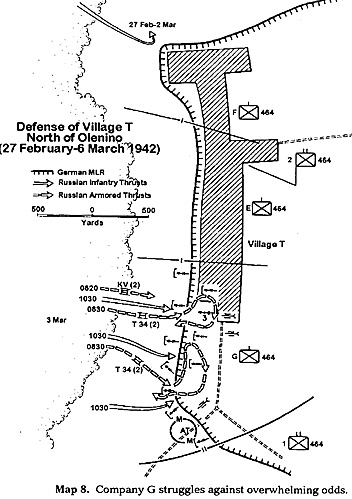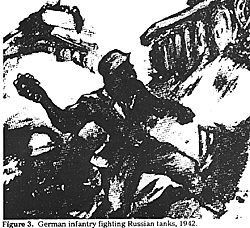
The following action shows a Russian regiment attacking eastward in an attempt to cut off some German units and link up with friendly forces moving in from the opposite direction. The attack methods employed by the Russian infantry showed that the troops were inadequately trained. The infantry units emerged from their jumpoff position in a disorderly manner, having the appearance of a disorganized herd that suddenly emerged from a forest. As soon as the Germans opened fire, panic developed in the ranks of the attack force. The infantrymen had to be driven forward by three or four officers with drawn pistols. In many instances any attempt to retreat or even to glance backward was punished with immediate execution. There was virtually no mutual fire support or coordinated fire.
Typical of Russian infantry tactics was the tenacity with which the attack was repeated over and over again. The Russians never abandoned ground which they had gained in an attack. Frequently, isolated Russian soldiers would feign death, only to surprise approaching Germans by suddenly coming to life and firing at them from close range.
In February 1942 the 2d Battalion of the 464th German Infantry Regiment occupied snow positions without bunkers or dugouts along the western edge of Village T, situated north of Olenino near the rail line leading from Rzhev to Velikiye-Luki (see Map 8). German reconnaissance patrols probing through the forest west of that village had been unable to establish contact with the Russians. Toward the end of February a reconnaissance patrol ascertained the presence of Russian forces in the forest. Subsequent information obtained from local inhabitants indicated that the Russians , were being reinforced for an attack. From 27 February to 2 March, detachments, consisting of about 80 Russians each, attacked daily in the same sector and at the same time. The attacks took place about 1 hour after sunrise and were directed against a point at the northwest edge of Village T. Every one of them was unsuccessful, the attacking Russians being wiped out before they could reach the German position.
On the evening of 2 March a Russian deserter reported that his infantry regiment, supported by six tanks, would attack Company G's sector, which was south of the village. To strengthen the defense of his sector the company commander, Lieutenant Viehmann, placed three 37 mm antitank guns behind the MLR and planted antitank mines across the road leading southwestward. Although his unit was understrength, Viehmann ordered d each platoon to form a reserve detachment of 10 men for a possible counterthrust.
 At daybreak on 3 March two Russian heavy tanks of the KV type, painted white to blend with the landscape, were spotted standing at the edge of the forest about 500 yards in front of Company G's sector. At 0820 Russian aircraft bombed the village, while the two tanks, about 150 yards apart, advanced another 100 yards, stopped, and opened fire at the most conspicuous German fortifications. At 0830 four more Russian tanks, this time T34s, emerged from the forest. They paired off, penetrated the right and center of Company G's MLR, and rolled up the stretch between the two points of penetration. Encountering no effective resistance, they pushed deeper into the German defensive position while providing mutual fire support. The three German 37 mm. antitank guns proved ineffective against the T34s and were quickly knocked out ' as were a number of German heavy weapons. However, without immediate infantry support the Russian tanks were incapable of achieving any further results.
At daybreak on 3 March two Russian heavy tanks of the KV type, painted white to blend with the landscape, were spotted standing at the edge of the forest about 500 yards in front of Company G's sector. At 0820 Russian aircraft bombed the village, while the two tanks, about 150 yards apart, advanced another 100 yards, stopped, and opened fire at the most conspicuous German fortifications. At 0830 four more Russian tanks, this time T34s, emerged from the forest. They paired off, penetrated the right and center of Company G's MLR, and rolled up the stretch between the two points of penetration. Encountering no effective resistance, they pushed deeper into the German defensive position while providing mutual fire support. The three German 37 mm. antitank guns proved ineffective against the T34s and were quickly knocked out ' as were a number of German heavy weapons. However, without immediate infantry support the Russian tanks were incapable of achieving any further results.
It was not until 2 hours later that approximately 300 Russian riflemen attacked from the forest, while the two KV tanks stood still and the T34s roamed at will through the depth of the German defensive position. Hampered by the deep snow, the infantry had to bunch up and advance along the tank tracks, offering easy targets during their slow movement. Despite the loss of many of their heavy weapons, the German defenders mustered sufficient strength to repel the Russian attack and to force the infantry to withdraw into the forest, the tanks following soon afterward. A short time later the four T34s reappeared. This time each tank carried a rifle squad. Additional infantry supported the attack. When the T34s reentered the German MLR three of them were eliminated by German infantrymen who threw antitank mines into their paths. The Russian foot infantry elements advanced 350 yards from the forest's edge before being pinned down by German mortar fire. The one tank that remained intact quickly withdrew into the forest, followed by the Russian infantry. Throughout the day the two KVs remained in the German outpost area and fired on everything that moved within the German position.
Russian prisoners taken during the fighting stated that the riflemen mounted on tanks had, been ordered to establish themselves within the German defensive position to support the Russian infantry's attack. These statements were confirmed when it was discovered that a number of small Russian detachments had infiltrated the German outpost area, from where they refused to be dislodged despite the severe cold. After dark, German combat patrols were finally able to move out and liquidate them.
All was quiet on 4 March. The next day the Russians resumed the attack all along the 2d Battalion sector with a force estimated at 2 to 3 infantry regiments and supported by 16 tanks. While the Russian artillery confined itself to harassing the German rear area, the mortars laid down intensive fire, whose effect was insignificant because of the deep snow. Severe fighting continued unabated until evening. After dark the Russians broke into the southern part of Village T at several points. By that time severe losses in men and materiel had greatly weakened the defending force. Nevertheless, the Germans held the northern part of Village T until the morning of 6 March, when they withdrew to a new position 2 miles farther east.
In this engagement the Russians demonstrated extraordinary skill in approaching through the snow-covered forests without attracting the attention of the Germans. They permitted small German reconnaissance patrols to pass at will to create the impression that the forest was clear.
The four limited attacks that preceded the main assault were either feints or reconnaissance thrusts in force. By repeating them against the same sector on 4 subsequent days, the Russians probably intended to divert German defense forces to that point.
During the main assault the teamwork between Russian tanks and infantry was inadequate. In this particular engagement the Russian infantry showed little aggressiveness, and the tanks had to advance alone to break up the German defense system before the infantry jumped off. Actually, the long interval between tank and infantry attacks had precisely the opposite effect. It is true that the Russian tank attack threw the German defense into temporary confusion, because the 37 mm. antitank guns were ineffective against the T34s and KVs and the German infantry lacked experience in combatting tanks at close range. Moreover, the two KV tanks acted as armored assault guns and prevented all movements within the German position. These often-used tactics were successful as long as the Germans did not have antitank guns whose projectiles could pierce the armor of these tanks. However, by the time the Russian infantry launched its attack two hours later, the defenders were able to overcome their initial fear of the giant KV tanks and to rally sufficient strength to frustrate the Russian infantry attack. When the Russian armor attacked for the second time, the German infantry knew how to cope with it effectively.
As in many other instances, the lower echelon Russian commanders revealed a certain lack of initiative in the execution of orders. Individual units were simply given a mission or a time schedule to which they adhered rigidly. This operating procedure had its obvious weaknesses. While the Russian soldier had the innate faculty of adapting himself easily to technological innovations and overcoming mechanical difficulties, the lower echelon commanders seemed incapable of coping with sudden changes in the situation and acting on their own initiative. Fear of punishment in the event of failure may have motivated their reluctance to make independent decisions.
The Russian troops employed in this action seemed to be particularly immune to extreme cold. Individual snipers hid in the deep snow throughout day or night, even at temperatures as low as -50 degrees F. In temperatures of -40 degrees F and below, the German machine guns often failed to function, and below -60 degrees F, some of the rifles failed to fire. In these temperatures the oil or grease congealed, jamming the bolt mechanism. Locally procured sunflower oil was used as a lubricant when available, as it guaranteed the proper functioning of weapons in subzero temperatures.
More Company G
-
Introduction
Company G Counterattacks During a Snowstorm (November 1941)
Company G Operates in Deep Snow (January 1942)
Russian Infantry Attacks a German-Held Town (January 1942)
Company G Struggles Against Overwhelming Odds (March 1942)
Company G Annihilates a Russian Elite Unit (March 1942)
Back to Table of Contents -- Combat Simulation Vol 1 No. 1
Back to Combat Simulation List of Issues
Back to MagWeb Magazine List
© Copyright 1994 by Mike Vogell and Phoenix Military Simulations.
This article appears in MagWeb (Magazine Web) on the Internet World Wide Web.
Other military history articles and gaming articles are available at http://www.magweb.com